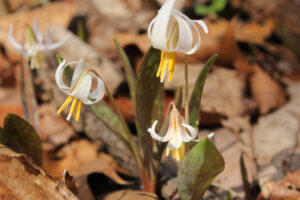By Bernheim
 For those of you who opened this blog in hopes of a detailed play-by-play on trout fishing, I apologize. This one goes out to all the wildflower fans out there.
For those of you who opened this blog in hopes of a detailed play-by-play on trout fishing, I apologize. This one goes out to all the wildflower fans out there.
I’m fairly novice when it comes to the realm of native wildflowers in Kentucky, but I do have one thing going for me, and that’s curiosity of place and all things nature.
The genus Erythronium, commonly known as trout lily, fawn lily, glacier lily, or dog-tooth violet (depending on the species and where you are in the world), is the first spring wildflower I’ve stumbled upon at Bernheim that really caught my attention. My initial sighting of an individual flower soon led to discovery of the white showy clusters scattered amongst the forest floor. I was fascinated by the cluster’s incandescence in contrast to the brown leaf litter. The yellow trout lily species is considered by some to be more common than the white variety, making my discovery feel all the more unique.
So, first things first: why the common name referencing to our fish friend, the trout? The name trout lily is given because of the resemblance of the two mottled brown basal leaves that hug the ground to the markings of brown or brook trout. The second reason is due to the arrival of its flowers appearing during trout fishing season in Kentucky. I’ve also read the dog-tooth violet reference comes from the resemblance of the corm (stem tissue that stores food) to a dog’s tooth.
Each trout lily flower blooms once for a couple of days, then the plant fades into dormancy until the following year. Its pollen is a very useful source of nectar this time of year for native bees. The unique pendant position of its flowers allows the petals (technically tepals) to limit the possibility of damage to pollen from rain or harsh wind. The tepals also offer protection because they can close in rain or during periods of low light.
 My Wildflowers and Ferns of Kentucky guide informs me that their preferred habitat is dappled shade and rich, moist woods. It can take up to 8 years before individual plants will flower in the forest, so if you find them, reflect on the time it took for what you are viewing to come forth! These individual ephemeral flowers are only open for business a few days, so catch them while you can.
My Wildflowers and Ferns of Kentucky guide informs me that their preferred habitat is dappled shade and rich, moist woods. It can take up to 8 years before individual plants will flower in the forest, so if you find them, reflect on the time it took for what you are viewing to come forth! These individual ephemeral flowers are only open for business a few days, so catch them while you can.


